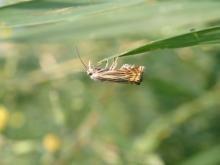Large sod webworm (Pediasia trisecta)
Pest description and crop damage The large sod webworm is a larvae of "lawn moths." The moths are characterized by wings that are partially folded around the body giving the moths a very slender appearance as well as a pronounced "snout." The large sod webworm is one of the larger webworms with a wingspan of 21 to 35 mm. The wings are usually white, grey or tan, and may have patterns of silver, gold, copper or other colored scale. Larvae can cause considerable damage to turf areas if conditions favor their development. However, due to the high natural mortality of small larvae, damage is seldom severe. The presence of larvae is indicated by dying back of grass shoots until irregular brown spots occur. Close examination usually shows leaf blades chewed off at base of plant.
Biology and life history The large sod webworm overwinters as larvae in the soil. Adults emerge in late May through June. Moths have erratic flight, move freely over the lawn about dusk, and are attracted to light. Adults lay eggs shortly after emergence. Eggs hatch in 5 to 14 days and the young larvae feed on the tender young grass leaves, spinning a protective silky web. As the larvae mature, they construct subterranean burrows and feed only at night. In the PNW, the larval stage lasts through the winter and may involve as many as 8 instars.
Scouting and thresholds Worms (caterpillars) or worm droppings can be detected by breaking apart a section of dying sod. Thresholds for larval numbers have not been established in the PNW.
Management-biological control
- Bacillus thuringiensis-Some formulations are OMRI-listed for organic use.
- beneficial nematodes
Management-chemical control
Products for home use
- bifenthrin-Restricted use
- carbaryl
- deltamethrin
- fenvalerate
- gamma-cyhalothrin
- indoxacarb
- lambda-cyhalothrin
- permethrin
- plant essential oils-Some formulations are OMRI-listed for organic use.
- pyrethrins-Some formulations are OMRI-listed for organic use.
- tetraniliprole
Products for commercial use
- acephate
- azadiractin-OMRI-listed for organic use.
- beta-cyfluthrin
- bifenthrin-Restricted use
- bifenthrin + imidacloprid-Some neonicotinoids have been banned from use on public properties.
- carbaryl
- chlorantraniliprole
- clothianidin-Some neonicotinoids have been banned from use on public properties.
- clothianidin + bifenthrin-Restricted use
- cyantraniliprole
- cyfluthrin
- cypermethrin
- deltamethrin
- dinotefuran-Some neonicotinoids have been banned from use on public properties.
- esfenvalerate + prallethrin + piperonyl butoxide
- gamma-cyhalothrin
- indoxacarb
- lambda-cyhalothrin
- methomyl
- mint oil, geraniol + oil of rosemary-OMRI-listed for organic use.
- spinosad-Some formulations are OMRI-listed for organic use.
- thiamethoxam-Some neonicotinoids have been banned from use on public properties.
- trichlorfon



